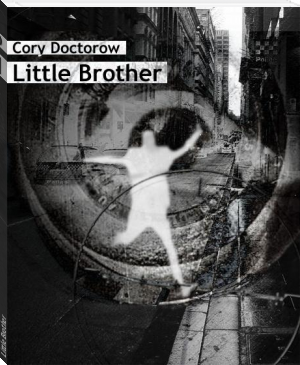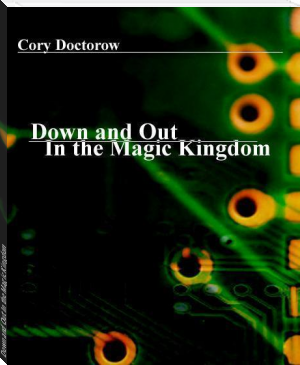Little Brother, Cory Doctorow [thriller novels to read .TXT] 📗

- Author: Cory Doctorow
Book online «Little Brother, Cory Doctorow [thriller novels to read .TXT] 📗». Author Cory Doctorow
Unfortunately, the combination of not complying with social norms and knowing “threatening” things like how to read the arphid on your credit card or how to pick locks causes some people to fear hackers. However, the motivations of a hacker are typically as simple as “I’m an engineer because I like to design things.” People often ask me, “Why did you hack the Xbox security system?” And my answer is simple: First, I own the things that I buy. If someone can tell me what I can and can’t run on my hardware, then I don’t own it. Second, because it’s there. It’s a system of sufficient complexity to make good sport. It was a great diversion from the late nights working on my PhD.
I was lucky. The fact that I was a graduate student at MIT when I hacked the Xbox legitimized the activity in the eyes of the right people. However, the right to hack shouldn’t only be extended to academics. I got my start on hacking when I was just a boy in elementary school, taking apart every electronic appliance I could get my hands on, much to my parents’ chagrin. My reading collection included books on model rocketry, artillery, nuclear weaponry and explosives manufacture -- books that I borrowed from my school library (I think the Cold War influenced the reading selection in public schools). I also played with my fair share of ad-hoc fireworks and roamed the open construction sites of houses being raised in my Midwestern neighborhood. While not the wisest of things to do, these were important experiences in my coming of age and I grew up to be a free thinker because of the social tolerance and trust of my community.
Current events have not been so kind to aspiring hackers. Little Brother shows how we can get from where we are today to a world where social tolerance for new and different thoughts dies altogether. A recent event highlights exactly how close we are to crossing the line into the world of Little Brother. I had the fortune of reading an early draft of Little Brother back in November 2006. Fast forward two months to the end of January 2007, when Boston police found suspected explosive devices and shut down the city for a day. These devices turned out to be nothing more than circuit boards with flashing LEDs, promoting a show for the Cartoon Network. The artists who placed this urban graffiti were taken in as suspected terrorists and ultimately charged with felony; the network producers had to shell out a $2 million settlement, and the head of the Cartoon Network resigned over the fallout.
Have the terrorists already won? Have we given in to fear, such that artists, hobbyists, hackers, iconoclasts, or perhaps an unassuming group of kids playing Harajuku Fun Madness, could be so trivially implicated as terrorists?
There is a term for this dysfunction -- it is called an autoimmune disease, where an organism's defense system goes into overdrive so much that it fails to recognize itself and attacks its own cells. Ultimately, the organism self-destructs. Right now, America is on the verge of going into anaphylactic shock over its own freedoms, and we need to inoculate ourselves against this. Technology is no cure for this paranoia; in fact, it may enhance the paranoia: it turns us into prisoners of our own device. Coercing millions of people to strip off their outer garments and walk barefoot through metal detectors every day is no solution either. It only serves to remind the population every day that they have a reason to be afraid, while in practice providing only a flimsy barrier to a determined adversary.
The truth is that we can't count on someone else to make us feel free, and M1k3y won’t come and save us the day our freedoms are lost to paranoia. That's because M1k3y is in you and in me--Little Brother is a reminder that no matter how unpredictable the future may be, we don't win freedom through security systems, cryptography, interrogations and spot searches. We win freedom by having the courage and the conviction to live every day freely and to act as a free society, no matter how great the threats are on the horizon.
Be like M1k3y: step out the door and dare to be free.
BIBLIOGRAPHY
No writer creates from scratch -- we all engage in what Isaac Newton called "standing on the shoulders of giants." We borrow, plunder and remix the art and culture created by those around us and by our literary forebears.
If you liked this book and want to learn more, there are plenty of sources to turn to, online and at your local library or bookstore.
Hacking is a great subject. All science relies on telling other people what you've done so that they can verify it, learn from it, and improve on it, and hacking is all about that process, so there's plenty published on the subject.
Start with Andrew "Bunnie" Huang's "Hacking the Xbox," (No Starch Press, 2003) a wonderful book that tells the story of how Bunnie, then a student at MIT, reverse-engineered the Xbox's anti-tampering mechanisms and opened the way for all the subsequent cool hacks for the platform. In telling the story, Bunnie has also created a kind of Bible for reverse engineering and hardware hacking.
Bruce Schneier's "Secrets and Lies" (Wiley, 2000) and "Beyond Fear" (Copernicus, 2003) are the definitive lay-person's texts on understanding security and thinking critically about it, while his "Applied Cryptography" (Wiley, 1995) remains the authoritative source for understanding crypto. Bruce maintains an excellent blog and mailing list at schneier.com/blog. Crypto and security are the realm of the talented amateur, and the "cypherpunk" movement is full of kids, home-makers, parents, lawyers, and every other stripe of person, hammering away on security protocols and ciphers.
There are several great magazines devoted to this subject, but the two best ones are 2600: The Hacker Quarterly, which is full of pseudonymous, boasting accounts of hacks accomplished, and O'Reilly's MAKE magazine, which features solid HOWTOs for making your own hardware projects at home.
The online world overflows with material on this subject, of course. Ed Felten and Alex J Halderman's Freedom to Tinker (www.freedom-to-tinker.com) is a blog maintained by two fantastic Princeton engineering profs who write lucidly about security, wiretapping, anti-copying technology and crypto.
Don't miss Natalie Jeremijenko's "Feral Robotics" at UC San Diego (xdesign.ucsd.edu/feralrobots/). Natalie and her students rewire toy robot dogs from Toys R Us and turn them into bad-ass toxic-waste detectors. They unleash them on public parks where big corporations have dumped their waste and demonstrate in media-friendly fashion how toxic the ground is.
Like many of the hacks in this book, the tunneling-over-DNS stuff is real. Dan Kaminsky, a tunneling expert of the first water, published details in 2004 (www.doxpara.com/bo2004.ppt).
The guru of "citizen journalism" is Dan Gillmor, who is presently running Center for Citizen Media at Harvard and UC Berkeley -- he also wrote a hell of a book on the subject, "We, the Media" (O'Reilly, 2004).
If you want to learn more about hacking arphids, start with Annalee Newitz's Wired Magazine article "The RFID Hacking Underground" (www.wirednews.com/wired/archive/14.05/rfid.html). Adam Greenfield's "Everyware" (New Riders Press, 2006) is a chilling look at the dangers of a world of arphids.
Neal Gershenfeld's Fab Lab at MIT (fab.cba.mit.edu) is hacking out the world's first real, cheap "3D printers" that can pump out any object you can dream of. This is documented in Gershenfeld's excellent book on the subject, "Fab" (Basic Books, 2005).
Bruce Sterling's "Shaping Things" (MIT Press, 2005) shows how arphids and fabs could be used to force companies to build products that don't poison the world.
Speaking of Bruce Sterling, he wrote the first great book on hackers and the law, "The Hacker Crackdown" (Bantam, 1993), which is also the first book published by a major publisher that was released on the Internet at the same time (copies abound; see stuff.mit.edu/hacker/hacker.html for one). It was reading this book that turned me on to the Electronic Frontier Foundation, where I was privileged to work for four years.
The Electronic Frontier Foundation (www.eff.org) is a charitable membership organization with a student rate. They spend the money that private individuals give them to keep the Internet safe for personal liberty, free speech, due process, and the rest of the Bill of Rights. They're the Internet's most effective freedom fighters, and you can join the struggle just by signing up for their mailing list and writing to your elected officials when they're considering selling you out in the name of fighting terrorism, piracy, the mafia, or whatever bogeyman has caught their attention today. EFF also helps maintain TOR, The Onion Router, which is a real technology you can use right now
to get out of your government, school or library's censoring firewall (tor.eff.org).
EFF has a huge, deep website with amazing information aimed at a general audience, as do the American Civil Liberties Union (aclu.org), Public Knowledge (publicknowledge.org), FreeCulture (freeculture.org), Creative Commons (creativecommons.org) -- all of which also are worthy of your support. FreeCulture is an international student movement that actively recruits kids to found their own local chapters at their high schools and universities. It's a great way to get involved and make a difference.
A lot of websites chronicle the fight for cyberliberties, but few go at it with the verve of Slashdot, "News for Nerds, Stuff That Matters" (slashdot.org).
And of course, you have to
visit Wikipedia, the collaborative, net-authored encyclopedia that anyone can edit, with more than 1,000,000 entries in English alone. Wikipedia covers hacking and counterculture in astonishing depth and with amazing, up-to-the-nanosecond currency. One caution: you can't just look at the entries in Wikipedia. It's really important to look at the "History" and "Discussion" links at the top of every Wikipedia page to see how the current version of the truth was arrived at, get an appreciation for the competing points-of-view there, and decide for yourself whom you trust.
If you want to get at some real
forbidden knowledge, have a skim around Cryptome (cryptome.org), the world's most amazing archive of secret, suppressed and liberated information. Cryptome's brave publishers collect material that's been pried out of the state by Freedom of Information Act requests or leaked by whistle-blowers and publishes it.
The best fictional account of the history of crypto is, hands-down, Neal Stephenson's Cryptonomicon (Avon, 2002). Stephenson tells the story of Alan Turing and the Nazi Enigma Machine, turning it into a gripping war-novel that you won't be able to put down.
The Pirate Party mentioned in Little Brother is real and thriving in Sweden (www.piratpartiet.se), Denmark, the USA and France at the time of this writing (July, 2006). They're a little out-there, but a movement takes all kinds.
Speaking of out-there, Abbie Hoffman and the Yippies did indeed try to levitate the Pentagon, throw money into the stock exchange, and work with a group called the Up Against the Wall Motherf_____ers. Abbie Hoffman's classic book on ripping off the system, "Steal This Book," is back in print (Four Walls Eight Windows, 2002) and it's also online as a collaborative wiki for people who want to try to update it (stealthiswiki.nine9pages.com).
Hoffman's autobiography, "Soon to Be a Major Motion Picture" (also in print from Four Walls Eight Windows) is one of my favorite memoirs ever, even if it is highly fictionalized. Hoffman was an incredible storyteller and had great activist instincts. If you want to know how he really lived his life, though, try Larry Sloman's "Steal This Dream" (Doubleday, 1998).
More counterculture fun:





Comments (0)